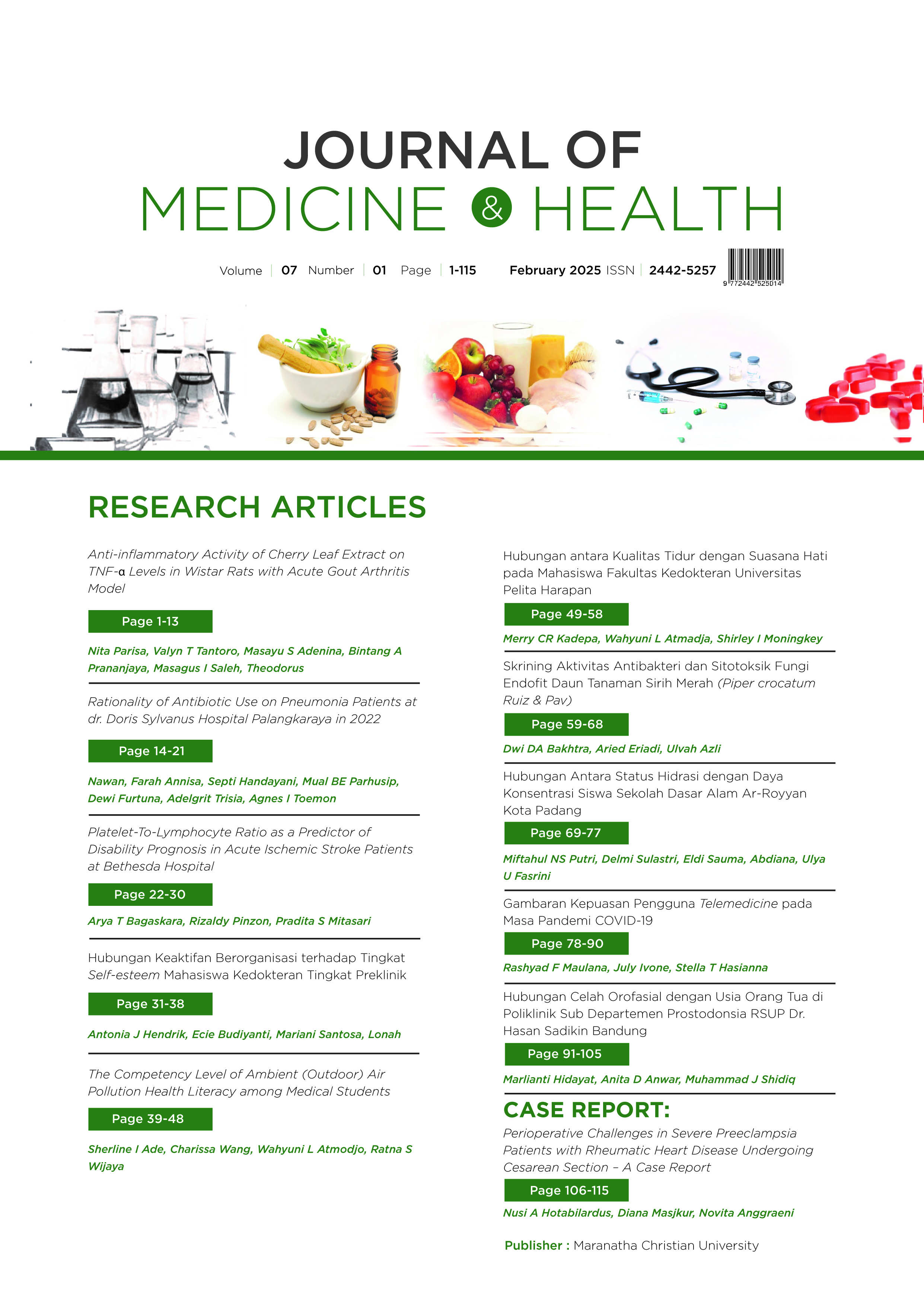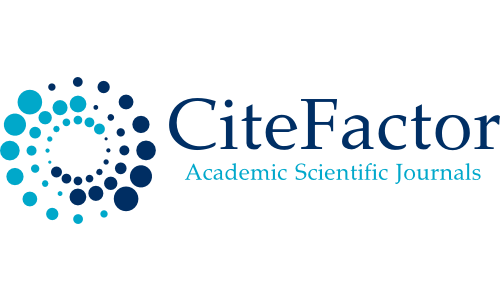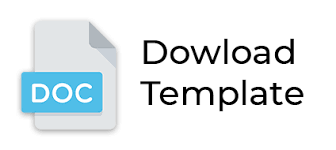The Competency Level of Ambient (Outdoor) Air Pollution Health Literacy among Medical Students
DOI:
https://doi.org/10.28932/jmh.v7i1.9205Keywords:
ambient air pollution, medical students, health literacyAbstract
Ambient (outdoor) air pollution causes worldwide health problem. One of the strategies for reducing ambient air pollution is to increase public participation, which depends on individual ambient air pollution health literacy (AAPHL). Medical professionals, including medical students, require a high level of AAPHL to support adequate health literacy in the community. However, the level of AAPHL of medical students is still unclear, particularly in areas with high levels of ambient air pollution in Indonesia, such as Jakarta and Tangerang. This study aims to evaluate the level and factors associated with AAPHL of medical students. The health literacy of ambient air pollution was assessed using a 24-item AAPHL questionnaire. This study included 107 participants whose mean of age was 19.63. Most participants were female (70%) and third-year medical students (51%). The mean of the total AAPHL scores was 2.85 out of 4. The highest score of competencies was noted for understanding health information, while the lowest was noted for appraising health information. No association between age, gender, and year of study with AAPHL score was found. In conclusion, the AAPHL level among medical students in Indonesia was considered moderate. The low appraising competency of AAPHL indicates a potential area for improvement.Downloads
References
Schraufnagel DE, Balmes JR, Cowl CT, De Matteis S, Jung SH, Mortimer K, et al. Air Pollution and Noncommunicable Diseases: A Review by the Forum of International Respiratory Societies' Environmental Committee, Part 1: The Damaging Effects of Air Pollution. Chest. 2019;155(2):409-16.
Franchini M, Mannucci PM, Harari S, Pontoni F, Croci E. The Health and Economic Burden of Air Pollution. Am J Med. 2015;128(9):931-2.
Syuhada G, Akbar A, Hardiawan D, Pun V, Darmawan A, Heryati SHA, et al. Impacts of Air Pollution on Health and Cost of Illness in Jakarta, Indonesia. Int J Environ Res Public Health. 2023;20(4):2916.
IQAir. Air quality in Indonesia [Internet]. 2024 [Cited 2024 June 20]. Available from: https://www.iqair.com/indonesia.
Environmental Agency of Jakarta and Vital Strategies. Strategy for air pollution control. 2022. [Cited 2024 July 10]. Available from: https://rendahemisi.jakarta.go.id/page/downloadContentFile/189.
Hou WH, Huang YC, Lu CY, Chen IC, Lee PC, Lin MY, et al. A national survey of ambient air pollution health literacy among adult residents of Taiwan. BMC Public Health. 2021;21(1):1604.
Finn S, O'Fallon L. The Emergence of Environmental Health Literacy- From Its Roots to Its Future Potential. Environ Health Perspect. 2017;125(4):495-501.
Gray KM. From Content Knowledge to Community Change: A Review of Representations of Environmental Health Literacy. Int J Environ Res Public Health. 2018;15(3).
Lindsey M, Chen SR, Ben R, Manoogian M, Spradlin J. Defining Environmental Health Literacy. Int J Environ Res Public Health. 2021;18(21):626
Quintyne KI, Kelly C. Knowledge, attitudes, and perception of air pollution in Ireland. Public Health Pract (Oxf). 2023;6:100406.
Qian X, Xu G, Li L, Shen Y, He T, Liang Y, et al. Knowledge and perceptions of air pollution in Ningbo, China. BMC Public Health. 2016;16(1):1138.
Chen IC, Li CY, Lu CY, Huang YC, Lee PC, Lin MY, et al. Psychometric properties of a novel instrument for evaluating ambient air pollution health literacy in adults. PLoS One. 2023;18(6):e0285001.
Alkharusi H. A descriptive analysis and interpretation of data from Likert scales in educational and psychological research. Indian J Psy Edu. 2022;12(2):13-6.
Cohen AJ, Brauer M, Burnett R, Anderson HR, Frostad J, Estep K, et al. Estimates and 25-year trends of the global burden of disease attributable to ambient air pollution: an analysis of data from the Global Burden of Diseases Study 2015. Lancet. 2017;389(10082):1907-18.
Liu C, Wang D, Liu C, Jiang J, Wang X, Chen H, et al. What is the meaning of health literacy? A systematic review and qualitative synthesis. Fam Med Community Health. 2020;8(2):e000351.
Shahid R, Shoker M, Chu LM, Frehlick R, Ward H, Pahwa P. Impact of low health literacy on patients' health outcomes: a multicenter cohort study. BMC Health Serv Res. 2022;22(1):1148.
Coughlin SS, Vernon M, Hatzigeorgiou C, George V. Health Literacy, Social Determinants of Health, and Disease Prevention and Control. J Environ Health Sci. 2020;6(1):3061.
Nakayama K, Osaka W, Togari T, Ishikawa H, Yonekura Y, Sekido A, et al. Comprehensive health literacy in Japan is lower than in Europe: a validated Japanese-language assessment of health literacy. BMC Public Health. 2015;15:505.
Pelikan JM, Ganahl K. Measuring Health Literacy in General Populations: Primary Findings from the HLS-EU Consortium's Health Literacy Assessment Effort. Stud Health Technol Inform. 2017;240:34-59.
Dinh HTT, Nguyen NT, Bonner A. Health literacy profiles of adults with multiple chronic diseases: A cross-sectional study using the Health Literacy Questionnaire. Nurs Health Sci. 2020;22(4):1153-60.
Stormacq C, Oulevey Bachmann A, Van den Broucke S, Bodenmann P. How socioeconomically disadvantaged people access, understand, appraise, and apply health information: A qualitative study exploring health literacy skills. PLoS One. 2023;18(8):e0288381.
Diviani N, Obrenovic J, Montoya CL, Karcz K. Disentangling health information appraisal competence: Results from an interdisciplinary scoping review and online consultation among Swiss stakeholders. PLoS One. 2020;15(7):e0235474.
Budhathoki SS, Pokharel PK, Jha N, Moselen E, Dixon R, Bhattachan M, et al. Health literacy of future healthcare professionals: a cross-sectional study among health sciences students in Nepal. Int Health. 2019;11(1):15-23.
Munangatire T, Tomas N, Mareka V. Nursing students' understanding of health literacy and health practices: a cross-sectional study at a university in Namibia. BMC Nurs. 2022;21(1):8.
Holt KA, Overgaard D, Engel LV, Kayser L. Health literacy, digital literacy and eHealth literacy in Danish nursing students at entry and graduate level: a cross-sectional study. BMC Nurs. 2020;19:22.
Zou M, Zhang Y, Zhang F, Hu P, Bai R, Huang W, et al. The ability to obtain, appraise and understand health information among undergraduate nursing students in a medical university in Chongqing, China. Nurs Open. 2018;5(3):384-92.
Cheong KY, Syed Mahmud SMB, Chng NW, Kwek GJ, Yan CC, Yeung MT. Cross-sectional survey of health literacy among health science students in Singapore. J Med Access. 2024;8:27550834231222382.
Elsborg L, Krossdal F, Kayser L. Health literacy among Danish university students enrolled in health-related study programs. Scand J Public Health. 2017;45(8):831-8.
Lane M, Dixon R, Donald KJ, Ware RS. Health literacy profiles of medical students in an Australian Doctor of Medicine program: A cross-sectional study using the Health Literacy Questionnaire. Health Promot J Austr. 2023;35(3):617-27.
Soltani A, Mafinejad MK, Tajik M, Moosapour H, Bayat T, Mohseni F. Effects of a curriculum integrating critical thinking on medical students' critical thinking ability in Iran: a quasi-experimental study. J Educ Eval Health Prof. 2021;18:14.
Milford E, Morrison K, Teutsch C, Nelson BB, Herman A, King M, et al. Out of the classroom and into the community: medical students consolidate learning about health literacy through collaboration with Head Start. BMC Med Educ. 2016;16:121.
Downloads
Published
How to Cite
Issue
Section
License
Copyright (c) 2025 Sherline I Ade, Charissa Wang, Wahyuni L Atmodjo, Ratna S Wijaya

This work is licensed under a Creative Commons Attribution-NonCommercial 4.0 International License.
Authors who publish with this journal agree to the following terms:
- Authors retain the copyright and grant the journal right of first publication with the work
simultaneously licensed under a Creative Commons Attribution-NonCommercial 4.0 International License that allows others to share the work with an acknowledgement of the work's authorship and initial publication in this journal. - Authors are able to enter into separate, additional contractual arrangements for the nonexclusive distribution of the journal's published version of the work (e.g., post it to an institutional repository or publish it in a book), with an acknowledgement of its initial publication in this journal.
 This work is licensed under a Creative Commons Attribution-NonCommercial 4.0 International License.
This work is licensed under a Creative Commons Attribution-NonCommercial 4.0 International License.

















